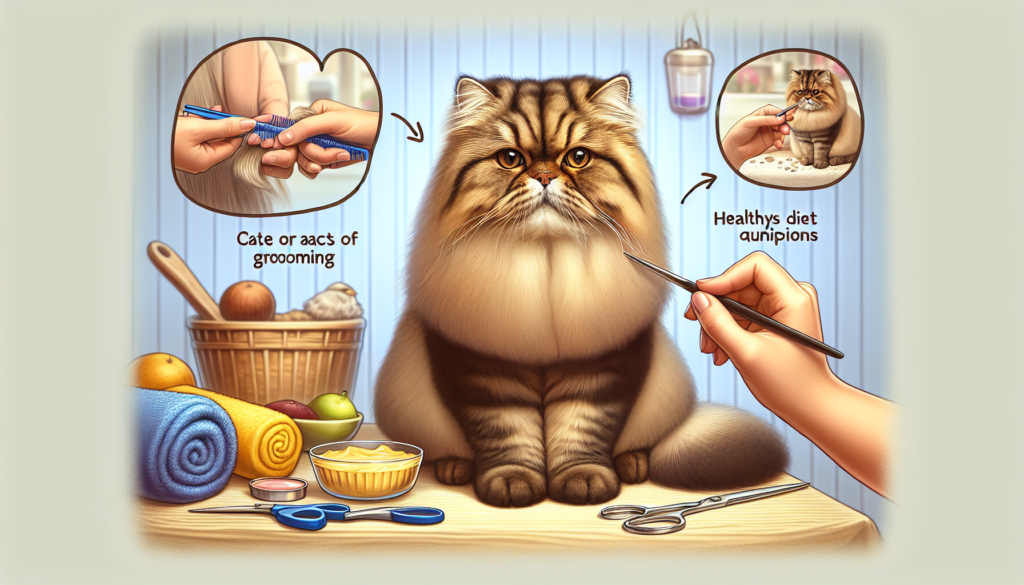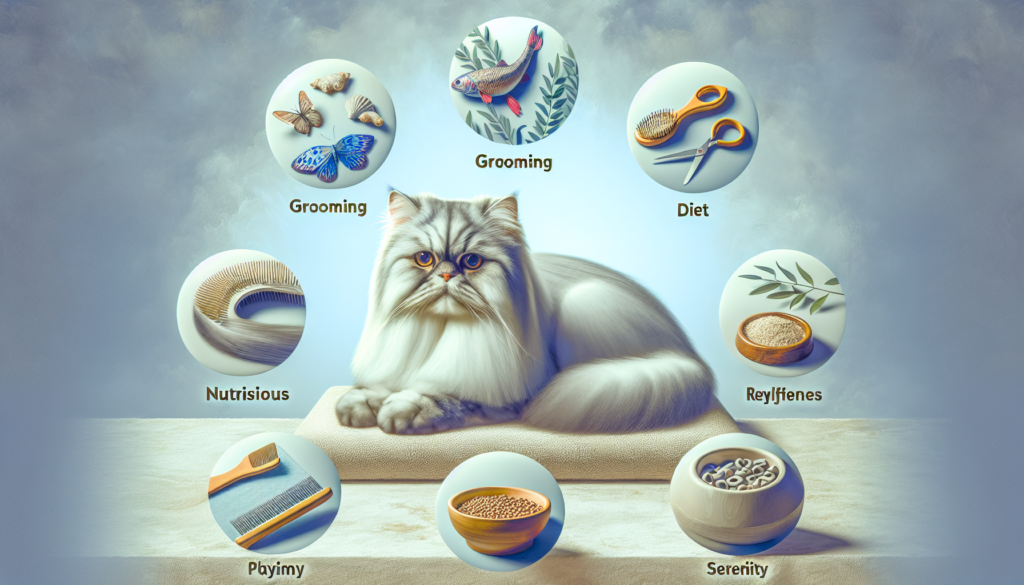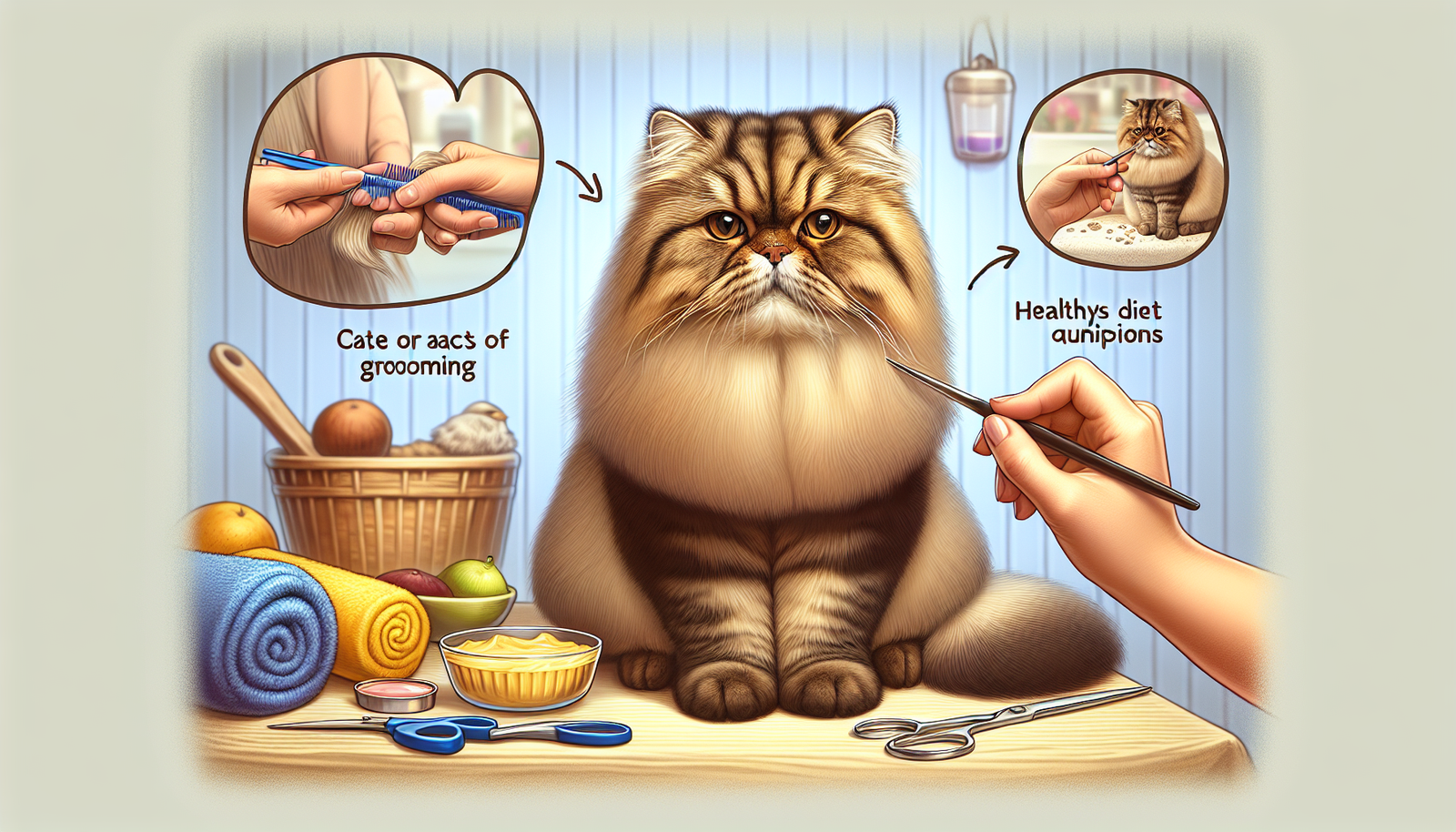Is your Persian cat feeling a little low or unenthusiastic lately? Well, fret not! We have compiled a list of 10 simple yet effective tips to keep your furry companion happy and content. From providing a comfortable living space to engaging them in interactive playtime, these practical suggestions are guaranteed to bring a smile to your Persian cat’s adorable face. So, if you’re ready to make your feline friend’s happiness a top priority, let’s dive right into these fantastic tips!

Proper Nutrition and Feeding
Choose a high-quality cat food
When it comes to keeping your Persian cat happy and healthy, providing them with a high-quality cat food is essential. Look for a brand that contains real meat as the primary ingredient and is free from artificial additives and fillers. Feeding your cat a nutritious diet will help support their overall well-being and provide them with the energy they need to thrive.
Feed a balanced diet
In addition to choosing the right cat food, it’s important to ensure that your Persian cat is receiving a balanced diet. This means providing them with a combination of protein, fat, carbohydrates, vitamins, and minerals that meet their specific nutritional needs. Consult with your veterinarian to determine the appropriate portion sizes and frequency of feeding for your cat’s age, weight, and activity level.
Provide fresh water
Just like humans, cats need access to fresh, clean water at all times. Make sure to change their water regularly to ensure its freshness. Having a water fountain can also encourage your cat to drink more, as some cats prefer running water. Adequate hydration is crucial for maintaining your cat’s overall health and preventing urinary tract issues.
Avoid overfeeding and obesity
While it may be tempting to constantly shower your Persian cat with treats, it’s important to remember to practice portion control and avoid overfeeding. Overfeeding can lead to obesity, which can increase the risk of various health problems, including diabetes, joint issues, and heart disease. Be mindful of the recommended portion sizes and avoid giving in to their pleading eyes for extra snacks.
Regular Grooming
Brush your Persian cat’s coat daily
Persian cats have long, luxurious coats that require regular grooming to keep them looking their best. Daily brushing helps to prevent tangles, mats, and excessive shedding. Not only does this keep your cat’s coat clean and healthy, but it also provides an opportunity for bonding and quality time with your furry friend. Invest in a good-quality brush and make brushing sessions a part of your daily routine.
Clean their eyes and ears regularly
Due to their unique facial structure, Persian cats are prone to eye discharge and ear wax buildup. Gently clean their eyes with a soft, damp cloth to remove any discharge. Additionally, use a cat-specific ear cleaner to clean their ears and prevent wax buildup. Regular cleaning of their eyes and ears will help prevent infections and discomfort.
Trim their nails
Long nails can be uncomfortable for your Persian cat and may lead to scratching-related issues, such as damage to furniture or unintentional injuries. Make nail trimming a regular part of their grooming routine. Use cat-specific nail clippers or enlist the help of a professional groomer if you’re unsure how to do it yourself. Be sure to reward your cat with praise or treats to make the experience positive for them.
Bathe your cat as needed
Persian cats have a long, dense coat that can occasionally require bathing. However, it’s important not to overdo it, as frequent bathing can strip their coat of natural oils. Only bathe your Persian cat when necessary, such as when they have gotten particularly dirty or have a skin condition that requires treatment. Use a cat-safe shampoo and rinse thoroughly to ensure all traces of soap are removed from their coat.
Create a Safe Environment
Keep toxic plants out of reach
Some common household plants, such as lilies, poinsettias, and certain ferns, can be toxic to cats if ingested. To ensure the safety of your Persian cat, make sure to keep these plants out of their reach. Consider placing them in areas where your cat doesn’t have access or opt for fake plants instead. It’s always better to err on the side of caution and prevent any potential harm to your furry friend.
Secure windows and balconies
Persian cats may be curious and enjoy looking out windows or exploring balconies. To keep them safe, make sure all windows and balconies are securely screened or closed off. This will prevent them from accidentally falling or escaping. Investing in window screens or balcony enclosures will give your cat the opportunity to enjoy the sights and fresh air while remaining safe.
Eliminate potential hazards
Cats love to explore and can be quite curious. It’s important to thoroughly cat-proof your home by eliminating any potential hazards that could harm your Persian cat. Secure loose cords, hide toxic substances, and ensure cabinets with cleaning products are inaccessible. Regularly check for small items, such as coins or rubber bands, that could be easily swallowed by your curious feline.
Provide hiding spots and vertical spaces
Creating a safe and stimulating environment for your Persian cat includes providing them with hiding spots and vertical spaces. Persian cats often enjoy perching on high surfaces to observe their surroundings, so invest in cat trees or install shelves they can climb on. Additionally, provide cozy hiding spots, such as cat caves or blankets, where your cat can retreat to when they want some alone time or feel anxious.
Provide Mental Stimulation
Use puzzle toys and interactive feeders
Engaging your Persian cat’s mind is just as crucial as providing them with physical exercise. Puzzle toys and interactive feeders are great tools to keep your cat mentally stimulated. These toys challenge their problem-solving abilities and provide a fun and rewarding way for them to enjoy their meals. Experiment with different types of toys and feeders to find what works best for your cat.
Rotate and introduce new toys
Cats can easily become bored with their toys if they are always available. Keep your Persian cat interested by rotating their toys regularly. Pack away a few toys and bring out new ones every few weeks. This way, they will always have something fresh and exciting to play with. Introducing interactive toys, such as feather wands or laser pointers, can also provide them with hours of entertainment.
Engage in interactive play sessions
Cats are natural hunters and need an outlet for their predatory instincts. Engaging in interactive play sessions with your Persian cat is a fantastic way to fulfill this need. Use toys that mimic prey, such as rodent-like toys or feather wands, and encourage your cat to chase, pounce, and pounce. Regular play sessions not only provide mental stimulation but also help create a strong bond between you and your furry companion.

Enrich their Environment
Create a cozy and quiet resting area
Like humans, cats need a place to retreat and relax. Create a cozy and quiet resting area for your Persian cat where they can feel safe and comfortable. Provide a soft bed or blanket in a quiet corner or a dedicated cat room. This space should be separate from any noisy household activities and offer a sense of security for your cat to unwind and recharge.
Offer scratching posts and cat trees
Cats have a natural instinct to scratch, and providing appropriate outlets for this behavior is crucial. Invest in scratching posts or cat trees that are tall and sturdy enough for your Persian cat to stretch and scratch on. Place them strategically around your home to encourage your cat to use them instead of your furniture. Offering various textures and materials, such as sisal, carpet, or cardboard, can help cater to your cat’s preferences.
Provide access to windows for bird watching
Cats are natural observers and love watching the world outside. Provide your Persian cat with a view by placing perches or cat trees near windows. This allows them to indulge in bird watching or simply soak in the sights and sounds of their surroundings. Just make sure the windows are secure and screened to prevent any escape attempts or accidents.
Ensure Regular Veterinary Care
Schedule annual check-ups
Regular veterinary care is essential to keep your Persian cat healthy and detect any potential issues early on. Schedule annual check-ups with your veterinarian to ensure that your cat’s vaccinations are up to date and their overall health is in good condition. These visits also provide an opportunity to discuss any concerns or ask questions about your cat’s specific needs.
Maintain vaccination and parasite prevention
Vaccinations are an important part of your Persian cat’s healthcare routine. Follow your veterinarian’s recommended vaccination schedule to protect your cat against common feline diseases. Additionally, make sure to keep up with parasite prevention, such as regular flea and tick treatments and deworming. These measures will help safeguard your cat’s health and well-being.
Monitor dental health
Oral health is often overlooked but crucial for your Persian cat’s overall well-being. Regularly check their teeth and gums for signs of dental issues, such as plaque buildup or redness. You can also introduce tooth brushing as part of their grooming routine. If you notice any problems or bad breath, consult your veterinarian for a dental check-up and appropriate treatment.
Address any health concerns promptly
Cats are masters at hiding signs of illness or discomfort, which makes it crucial for you to be vigilant and attentive to any changes in their behavior or habits. If you notice them eating, drinking, or using the litter box differently, or if they show signs of pain or discomfort, it’s important to seek veterinary help promptly. Addressing health concerns early can prevent further complications and ensure your Persian cat’s well-being.
Maintain a Consistent Routine
Stick to regular feeding times
Cats are creatures of habit and thrive on routine. Establish regular feeding times and stick to them as closely as possible. Consistency provides a sense of security for your Persian cat and helps maintain their overall well-being. Mealtime should be a predictable and enjoyable experience for both you and your feline companion.
Establish a daily play and exercise routine
Regular play and exercise are necessary for keeping your Persian cat physically and mentally stimulated. Set aside dedicated time each day to engage in interactive play sessions or provide opportunities for your cat to play on their own with toys. Incorporating exercise into their daily routine not only helps prevent obesity but also facilitates a healthy bond between you and your pet.
Maintain consistent grooming sessions
Persian cats require regular grooming to keep their coats looking their best. Establish a consistent grooming schedule and stick to it. Whether it’s daily brushing, weekly ear cleanings, or monthly baths, regular grooming sessions help maintain your cat’s hygiene and overall health. Regular grooming also allows you to monitor their skin condition and detect any abnormalities early on.
Provide Social Interaction
Spend quality time with your cat daily
Cats are social animals and need companionship and interaction with their humans. Make it a point to spend quality time with your Persian cat each day. Whether it’s cuddling on the couch, playing together, or simply sitting near each other, this time strengthens your bond and ensures your cat feels loved and valued.
Play and engage in interactive activities
Playtime is not only fun for your Persian cat but also crucial for their well-being. Take time each day to engage in interactive activities with them. Use toys that mimic prey and encourage their natural hunting instincts. This can be a great way to provide mental stimulation and physical exercise for your cat while strengthening the bond between you.
Consider adopting a companion
If you have the means and time to care for another cat, consider adopting a companion for your Persian cat. Cats are social creatures and can benefit from the company of another feline. Introducing a new cat into your household should be done gradually and with careful consideration, but it can provide your Persian cat with a lifelong friend and help prevent loneliness.
Promote a Stress-Free Environment
Create a calm and quiet living space
Cats are sensitive to their environment, and a calm and quiet living space promotes their overall well-being. Provide designated areas for your Persian cat to relax and retreat, away from any loud noises or commotion. This will help them feel safe and secure and reduce stress levels.
Introduce changes gradually
Cats are creatures of habit and can be sensitive to changes in their environment. If you need to make any changes, such as introducing new furniture, rearranging the house, or even bringing in new household members, do so gradually. Give your Persian cat time to adjust and provide plenty of reassurance and familiar comforts during the transition period.
Use pheromone diffusers
Pheromone diffusers, such as Feliway, can help create a calm and stress-free environment for your Persian cat. These diffusers release synthetic pheromones that mimic the ones cats naturally produce when they feel safe and secure. Placing them in areas where your cat spends the most time can help reduce anxiety and promote a sense of well-being.
Monitor Their Health and Behavior
Observe any changes in eating, drinking, or litter box habits
Your Persian cat’s eating, drinking, and litter box habits can provide important clues about their overall health. Pay close attention to any changes in these habits, such as increased or decreased appetite, excessive thirst, or changes in litter box behavior. These changes could be indicative of underlying health issues, and it’s important to consult your veterinarian if you notice any significant changes.
Keep an eye out for signs of pain or discomfort
Cats are masters at hiding signs of pain or discomfort, so it’s important to be vigilant and observant. Keep an eye out for any subtle changes in behavior, such as excessive grooming in one area, limping, or vocalization when touched. These signs could be indicative of pain or underlying health issues, and it’s important to address them promptly for your Persian cat’s well-being.
Seek veterinary help if necessary
If you notice any concerning changes in your Persian cat’s health or behavior, don’t hesitate to seek veterinary help. Your veterinarian is a valuable resource and can help diagnose and treat any underlying health issues. Regular veterinary care and open communication with your veterinarian are crucial for ensuring your Persian cat’s health and happiness.
By following these tips and providing your Persian cat with proper nutrition, regular grooming, a safe environment, mental stimulation, consistent routines, social interaction, a stress-free environment, and monitoring their health and behavior, you can create a happy and fulfilling life for your furry friend. Remember, a happy Persian cat is a healthy Persian cat!

